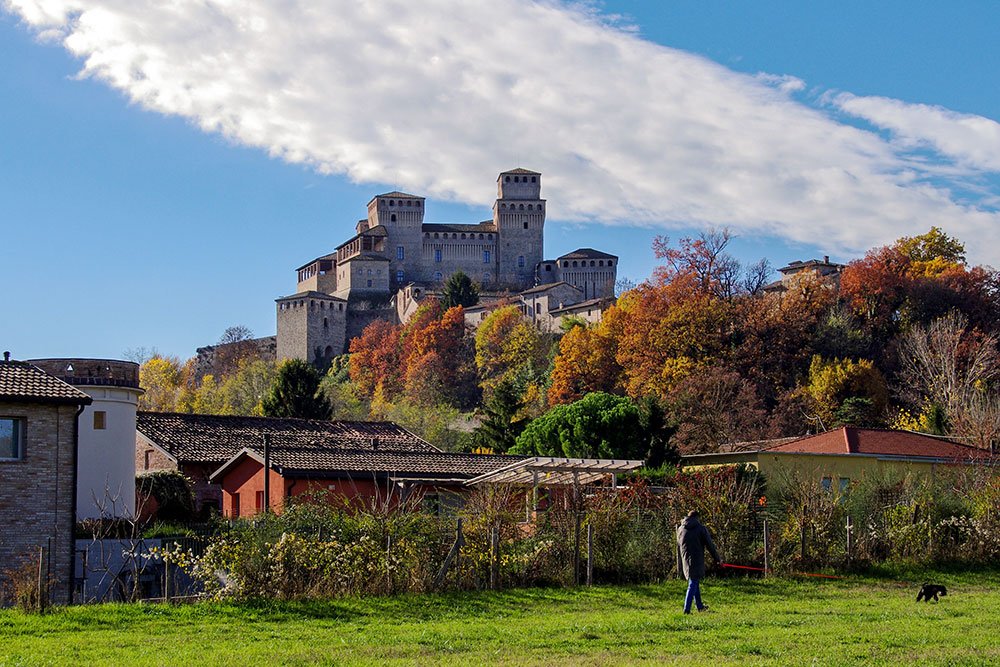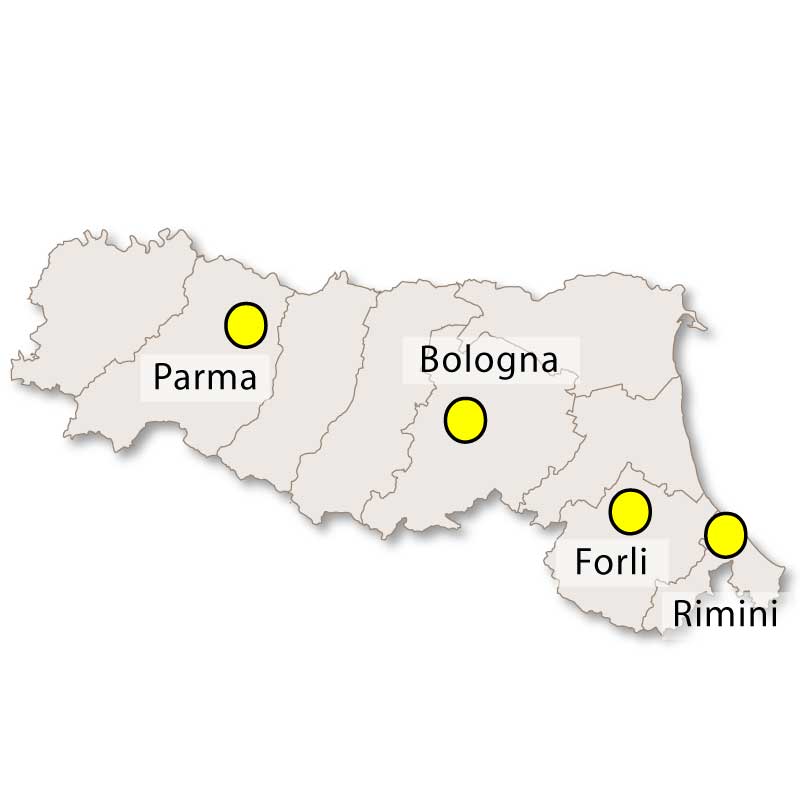
Emilia-Romagna is located in Northern Italy and evolved from the joining of two historic regions: Emilia and Romagna. The capital is Bologna. It has an area of 22,124 square kilometres and about 4.3 million inhabitants. The region is divided into nine provinces: Bologna, Ferrara, Forli-Cesena, Modena, Parma, Piacenza, Ravenna, Reggio Emilia and Rimini. Emilia-Romagna borders Liguria, Piedmont, Lombardia, Veneto, Le Marche and Tuscany.
Nearly half of the region (48%) consists of plains, while 27% is hilly and 25% mountainous. The region lies below the Apennines and the extensive Po River plain, where most of the land is flat. With the exception of the Po, the region’s main rivers descend from the Apennines—among them the Trebbia, Taro, Secchia, Panaro, Reno, Ronco, Montone, and Savio.
The region is seen as a bridge between two very distinct geographical systems: the continental north and the peninsular south. It marks the division between the colder northern lands (where winter temperatures can drop to -15°C) and the sunnier south (where they can reach 45°C).
Emilia-Romagna is one of the wealthiest regions in Italy and among the richest and most developed in Europe. Bologna is known for its high quality of life and advanced social services, and it’s home to the oldest university in the Western world. The Renaissance cities of Modena, Parma and Ferrara contribute to the region’s strong cultural reputation.
The region has a large food-processing industry, and livestock and dairy farming are extensive. Emilia-Romagna is also a hub for manufacturing—including cars, farm machinery, pharmaceuticals, and clothing. Large deposits of natural gas and oil near Piacenza are significant for Italy’s economy.
Several world-famous automotive and motorcycle manufacturers are based here: Ferrari, Lamborghini, Maserati, and Ducati. Emilia-Romagna also hosts the Emilia Romagna Grand Prix in Imola, near Bologna.
The coastline is lively and colourful, home to popular resorts such as Cattolica and Rimini. It features a wide stretch of sandy beaches, nature reserves, lagoons, pine forests, headlands, and lidos.
Before Roman times, Emilia-Romagna was part of the Etruscan world, later inhabited by Celtic Gauls. For centuries, it was a vital region for trade and religion, with many monasteries. Between the 9th century BC and Roman colonisation, cities like Cesena, Parma, Piacenza, and Modena began to flourish.
After the fall of the Roman Empire in the 6th century, the area became part of the Lombard kingdom. Charlemagne overthrew the dynasty, and Romagna came under Byzantine rule with Ravenna as its capital. In the 8th century, Charlemagne’s son gave the region to the Pope, placing it under Papal rule for several centuries.
The University of Bologna was established in the 11th century. The Este dynasty rose to power, supporting the arts and leaving a strong creative legacy. The 15th and 16th centuries saw cultural flourishing, producing poets like Ludovico Ariosto and Matteo Maria Boiardo.
In the 1800s, the region came under Napoleon’s rule, then French control. The push for Italian unification had begun, and Emilia officially joined the Kingdom of Italy in 1861. Agriculture was restructured, creating an agricultural proletariat and class conflicts that shaped the region’s identity. Workers' institutions became central to modern Emilia-Romagna.
After World War I, the region experienced social and political unrest, with high levels of violence. World War II brought devastation—Bologna, in particular, suffered severe damage. Yet the region rose again during Italy’s economic miracle, developing a progressive political and social model known as “The Emilian Model.” In 1948, Emilia merged with the newly autonomous Romagna.
The Po Delta is characterised by vast wetlands and rich biodiversity. The region's lower hills give way to the rising Apennines, where elevations can exceed 2,000 metres. The fertile central area produces many of the region’s food staples. In the east, the largely treeless land is cultivated with wheat.
Two important natural heritage sites can be found here: the Tuscan-Emilian Apennine National Park and Casentinesi Forest National Park. These areas protect the natural environment while offering scenic beauty and opportunities for exploration.
The Via Emilia is the region’s ancient artery, stretching 260 km from Piacenza to Rimini. Built by the Roman consul Marcus Aemilius Lepidus, this historic road still exists in parts today and gives the region its name.
Tourists flock to Emilia-Romagna for its medieval cities, Byzantine mosaics, Adriatic beaches, and globally celebrated cuisine.
Some of the region’s best-known food exports include:
Parma ham and Parmigiano Reggiano (from Parma)
Balsamic vinegar (from Modena)
Mortadella Bologna and the original Bolognese sauce
Traditional dishes such as tagliatelle al ragù, lasagne alla Bolognese, and Piadina Romagnola
UNESCO has recognized three sites in Emilia-Romagna:
The Mosaics of Ravenna
The Porticoes of Bologna
The Delizie Estensi (the Este family residences in Ferrara)
These cultural sites underscore the region’s long legacy of art, religion, and architectural achievement.
Modern Emilia-Romagna remains politically left-leaning, a trait it has held since World War II. Although there have been proposals to divide Emilia and Romagna or reduce its nine provinces to four, these plans were ultimately abandoned. The region continues to blend historical depth, cultural richness, economic strength, and progressive values.

More Details



